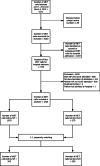Comparison of clinical outcomes between nurse practitioner and registrar-led medical emergency teams: a propensity-matched analysis
- PMID: 33752731
- PMCID: PMC7986296
- DOI: 10.1186/s13054-021-03534-4
Comparison of clinical outcomes between nurse practitioner and registrar-led medical emergency teams: a propensity-matched analysis
Abstract
Objective: Medical emergency teams (MET) are mostly led by physicians. Some hospitals are currently using nurse practitioners (NP) to lead MET calls. These are no studies comparing clinical outcomes between these two care models. To determine whether NP-led MET calls are associated with lower risk of acute patient deterioration, when compared to intensive care (ICU) registrar (ICUR)-led MET calls.
Methods: The composite primary outcome included recurrence of MET call, occurrence of code blue or ICU admission within 24 h. Secondary outcomes were mortality within 24 h of MET call, length of hospital stay, hospital mortality and proportion of patients discharged home. Propensity score matching was used to reduce selection bias from confounding factors between the ICUR and NP group.
Results: A total of 1343 MET calls were included (1070 NP, 273 ICUR led). On Univariable analysis, the incidence of the primary outcome was higher in ICUR-led MET calls (26.7% vs. 20.6%, p = 0.03). Of the secondary outcome measures, mortality within 24 h (3.4% vs. 7.7%, p = 0.002) and hospital mortality (12.7% vs. 20.5%, p = 0.001) were higher in ICUR-led MET calls. Propensity score-matched analysis of 263 pairs revealed the composite primary outcome was comparable between both groups, but NP-led group was associated with reduced risk of hospital mortality (OR 0.57, 95% CI 0.35-0.91, p = 0.02) and higher likelihood of discharge home (OR 1.55, 95% CI 1.09-2.2, p = 0.015).
Conclusion: Acute patient deterioration was comparable between ICUR- and NP-led MET calls. NP-led MET calls were associated with lower hospital mortality and higher likelihood of discharge home.
Keywords: Deterioration; Discharge; Medical emergency team; Mortality.
Conflict of interest statement
The authors declare that they have no competing interests.
Figures
Similar articles
-
A propensity matched cost analysis of medical emergency team calls led by nurse practitioners versus intensive care registrars.Intensive Crit Care Nurs. 2025 Feb;86:103819. doi: 10.1016/j.iccn.2024.103819. Epub 2024 Sep 9. Intensive Crit Care Nurs. 2025. PMID: 39255615
-
Predicting medical emergency team calls, cardiac arrest calls and re-admission after intensive care discharge: creation of a tool to identify at-risk patients.Anaesth Intensive Care. 2018 Jan;46(1):88-96. doi: 10.1177/0310057X1804600113. Anaesth Intensive Care. 2018. PMID: 29361261
-
Impact of nonphysician staffing on outcomes in a medical ICU.Chest. 2011 Jun;139(6):1347-1353. doi: 10.1378/chest.10-2648. Epub 2011 Mar 10. Chest. 2011. PMID: 21393397
-
Call Center Remote Triage by Nurse Practitioners Was Associated With Fewer Subsequent Face-to-Face Healthcare Visits.J Gen Intern Med. 2021 Aug;36(8):2315-2322. doi: 10.1007/s11606-020-06536-0. Epub 2021 Jan 26. J Gen Intern Med. 2021. PMID: 33501532 Free PMC article.
-
The outcomes of nurse practitioner (NP)-Provided home visits: A systematic review.Geriatr Nurs. 2020 Nov-Dec;41(6):962-969. doi: 10.1016/j.gerinurse.2020.07.001. Epub 2020 Jul 24. Geriatr Nurs. 2020. PMID: 32718756 Free PMC article.
Cited by
-
Comparing Nurse-Led and Physician-Led Bilevel Positive Airway Pressure Management in Hypercapnic Respiratory Failure: A Retrospective Cohort Study.Nurs Open. 2025 Apr;12(4):e70232. doi: 10.1002/nop2.70232. Nurs Open. 2025. PMID: 40263671 Free PMC article.
-
Advanced Practice Providers as Leaders of a Rapid Response Team: A Prospective Cohort Study.Healthcare (Basel). 2022 Oct 25;10(11):2122. doi: 10.3390/healthcare10112122. Healthcare (Basel). 2022. PMID: 36360463 Free PMC article.
-
Advanced practice providers versus medical residents as leaders of rapid response teams: A 12-month retrospective analysis.PLoS One. 2022 Aug 23;17(8):e0273197. doi: 10.1371/journal.pone.0273197. eCollection 2022. PLoS One. 2022. PMID: 35998147 Free PMC article.
-
27 Years of retention outcomes for a nine-university primary health care nurse practitioner program in Ontario, Canada.BMC Prim Care. 2025 Jul 31;26(1):234. doi: 10.1186/s12875-025-02874-2. BMC Prim Care. 2025. PMID: 40745262 Free PMC article.
References
-
- Mitchell OJL, Motschwiller CW, Horowitz JM, Evans LE, Mukherjee V. Characterising variation in composition and activation criteria of rapid response and cardiac arrest teams: a survey of Medicare participating hospitals in five American states. BMJ Open. 2019;9(3):e024548. doi: 10.1136/bmjopen-2018-024548. - DOI - PMC - PubMed
MeSH terms
LinkOut - more resources
Full Text Sources
Other Literature Sources
Miscellaneous


